AMD's Radeon HD 5870: Bringing About the Next Generation Of GPUs
by Ryan Smith on September 23, 2009 9:00 AM EST- Posted in
- GPUs
Eyefinity
Somewhere around 2006 - 2007 ATI was working on the overall specifications for what would eventually turn into the RV870 GPU. These GPUs are designed by combining the views of ATI's engineers with the demands of the developers, end-users and OEMs. In the case of Eyefinity, the initial demand came directly from the OEMs.
ATI was working on the mobile version of its RV870 architecture and realized that it had a number of DisplayPort (DP) outputs at the request of OEMs. The OEMs wanted up to six DP outputs from the GPU, but with only two active at a time. The six came from two for internal panel use (if an OEM wanted to do a dual-monitor notebook, which has happened since), two for external outputs (one DP and one DVI/VGA/HDMI for example), and two for passing through to a docking station. Again, only two had to be active at once so the GPU only had six sets of DP lanes but the display engines to drive two simultaneously.
ATI looked at the effort required to enable all six outputs at the same time and made it so, thus the RV870 GPU can output to a maximum of six displays at the same time. Not all cards support this as you first need to have the requisite number of display outputs on the card itself. The standard Radeon HD 5870 can drive three outputs simultaneously: any combination of the DVI and HDMI ports for up to 2 monitors, and a DisplayPort output independent of DVI/HDMI. Later this year you'll see a version of the card with six mini-DisplayPort outputs for driving six monitors.

It's not just hardware, there's a software component as well. The Radeon HD 5000 series driver allows you to combine all of these display outputs into one single large surface, visible to Windows and your games as a single display with tremendous resolution.
I set up a group of three Dell 24" displays (U2410s). This isn't exactly what Eyefinity was designed for since each display costs $600, but the point is that you could group three $200 1920 x 1080 panels together and potentially have a more immersive gaming experience (for less money) than a single 30" panel.
For our Eyefinity tests I chose to use every single type of output on the card, that's one DVI, one HDMI and one DisplayPort:
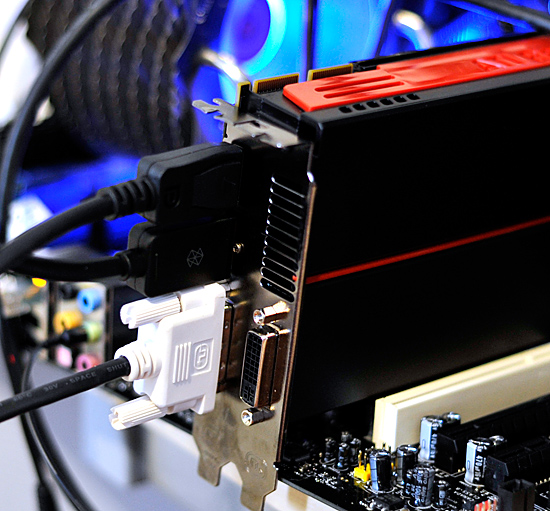
With all three outputs connected, Windows defaults to cloning the display across all monitors. Going into ATI's Catalyst Control Center lets you configure your Eyefinity groups:

With three displays connected I could create a single 1x3 or 3x1 arrangement of displays. I also had the ability to rotate the displays first so they were in portrait mode.

You can create smaller groups, although the ability to do so disappeared after I created my first Eyefinity setup (even after deleting it and trying to recreate it). Once you've selected the type of Eyefinity display you'd like to create, the driver will make a guess as to the arrangement of your panels.

If it guessed correctly, just click Yes and you're good to go. Otherwise ATI has a handy way of determining the location of your monitors:

With the software side taken care of, you now have a Single Large Surface as ATI likes to call it. The display appears as one contiguous panel with a ridiculous resolution to the OS and all applications/games:

Three 24" panels in a row give us 5760 x 1200
The screenshot above should clue you into the first problem with an Eyefinity setup: aspect ratio. While the Windows desktop simply expands to provide you with more screen real estate, some games may not increase how much you can see - they may just stretch the viewport to fill all of the horizontal resolution. The resolution is correctly listed in Batman Arkham Asylum, but the aspect ratio is not (5760:1200 !~ 16:9). In these situations my Eyefinity setup made me feel downright sick; the weird stretching of characters as they moved towards the outer edges of my vision left me feeling ill.
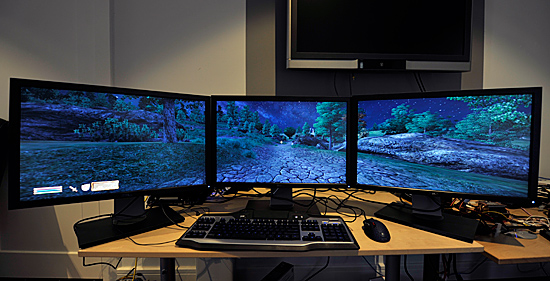
Dispite Oblivion's support for ultra wide aspect ratio gaming, by default the game stretches to occupy all horizontal resolution
Other games have their own quirks. Resident Evil 5 correctly identified the resolution but appeared to maintain a 16:9 aspect ratio without stretching. In other words, while my display was only 1200 pixels high, the game rendered as if it were 3240 pixels high and only fit what it could onto my screens. This resulted in unusable menus and a game that wasn't actually playable once you got into it.
Games with pre-rendered cutscenes generally don't mesh well with Eyefinity either. In fact, anything that's not rendered on the fly tends to only occupy the middle portion of the screens. Game menus are a perfect example of this:
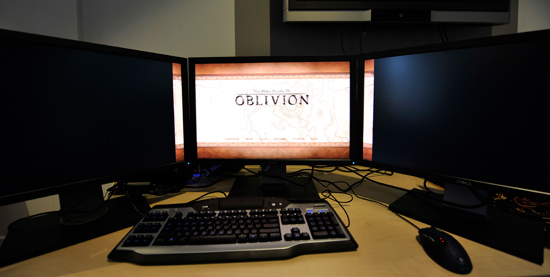
There are other issues with Eyefinity that go beyond just properly taking advantage of the resolution. While the three-monitor setup pictured above is great for games, it's not ideal in Windows. You'd want your main screen to be the one in the center, however since it's a single large display your start menu would actually appear on the leftmost panel. The same applies to games that have a HUD located in the lower left or lower right corners of the display. In Oblivion your health, magic and endurance bars all appear in the lower left, which in the case above means that the far left corner of the left panel is where you have to look for your vitals. Given that each panel is nearly two feet wide, that's a pretty far distance to look.
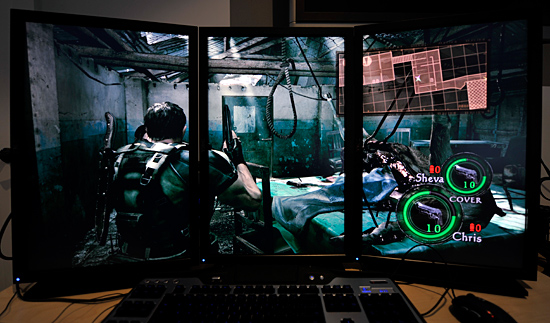
The biggest issue that everyone worried about was bezel thickness hurting the experience. To be honest, bezel thickness was only an issue for me when I oriented the monitors in portrait mode. Sitting close to an array of wide enough panels, the bezel thickness isn't that big of a deal. Which brings me to the next point: immersion.
The game that sold me on Eyefinity was actually one that I don't play: World of Warcraft. The game handled the ultra wide resolution perfectly, it didn't stretch any content, it just expanded my viewport. With the left and right displays tilted inwards slightly, WoW was more immersive. It's not so much that I could see what was going on around me, but that whenever I moved forward I I had the game world in more of my peripheral vision than I usually do. Running through a field felt more like running through a field, since there was more field in my vision. It's the only example where I actually felt like this was the first step towards the holy grail of creating the Holodeck. The effect was pretty impressive, although costly given that I only really attained it in a single game.
Before using Eyefinity for myself I thought I would hate the bezel thickness of the Dell U2410 monitors and I felt that the experience wouldn't be any more engaging. I was wrong on both counts, but I was also wrong to assume that all games would just work perfectly. Out of the four that I tried, only WoW worked flawlessly - the rest either had issues rendering at the unusually wide resolution or simply stretched the content and didn't give me as much additional viewspace to really make the feature useful. Will this all change given that in six months ATI's entire graphics lineup will support three displays? I'd say that's more than likely. The last company to attempt something similar was Matrox and it unfortunately didn't have the graphics horsepower to back it up.
The Radeon HD 5870 itself is fast enough to render many games at 5760 x 1200 even at full detail settings. I managed 48 fps in World of Warcraft and a staggering 66 fps in Batman Arkham Asylum without AA enabled. It's absolutely playable.
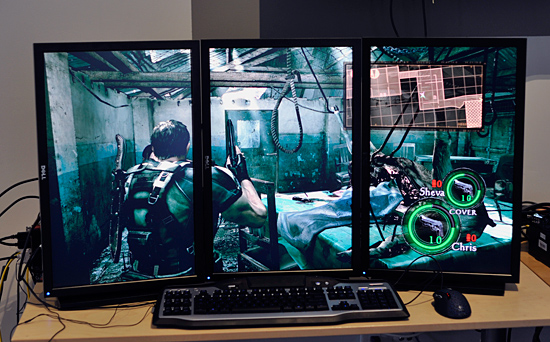










327 Comments
View All Comments
Ryan Smith - Wednesday, September 23, 2009 - link
We do have Cyberlink's software, but as it uses different code paths, the results are near-useless for a hardware review. Any differences could be the result of hardware differences, or it could be that one of the code paths is better optimized. We would never be able to tell.Our focus will always be on benchmarking the same software on all hardware products. This is why we bent over backwards to get something that can use DirectCompute, as it's a standard API that removes code paths/optimizations from the equation (in this case we didn't do much better since it was a NVIDIA tech demo, but it's still an improvement).
DukeN - Wednesday, September 23, 2009 - link
I have one of these and I know it outperforms the GTX 280 but not sure what it'd be like against one of these puppies.dagamer34 - Wednesday, September 23, 2009 - link
I need my bitstream Dolby Digital TrueHD/DTS HD Master Audio bistreaming codecs!!! :)ew915 - Wednesday, September 23, 2009 - link
I don't see this beating the GT300 as for so it should beat the GTX295 by a great margin.tamalero - Wednesday, September 23, 2009 - link
dood, you forgot the 295 is a DUAL CHIP?SiliconDoc - Wednesday, September 23, 2009 - link
roflmao - Gee no more screaming the 4850x2 and the 4870x2 are best without pointing out the two gpu's needed to get there.--
Nonetheless, this 5870 is EPIC FAIL, no matter what - as we see the disappointing numbers - we all see them, and it's not good.
---
Problem is, Nvidia has the MIMD multiple instructions breakthrough technology never used before that according to reports is an AWESOME advantage, lus they are moving to DDR5 with a 512 bit bus !
--
So what is in the works is an absolute WHOMPING coming down on ati that BIG GREEN NVIDIA is going to deliver, and the poor numbers here from what was hoped for and hyped over (although even PREDICTED by the red fan Derek himself in one portion of one sorrowful and despressed sentence on this site) are just one step closer to that nail in the coffin...
--
Yes I sure hope ati has something major up it's sleeve, like 512 bit mem bus increased card coming, the 5870Xmem ...
I find the speculation that ATI "mispredicted" the bandwidth needs to be utter non-sense. They are 2-3 billion in the hole from the last few years with "all these great cards" they still lose $ on every single sale, so they either cannot go higher bit width, or they don't want to, or they are hiding it for the next "strike at NVidia" release.
erple2 - Friday, September 25, 2009 - link
So you're comparing this product with a not yet release product and saying that the not yet released product is going to trounce it, without any facts to back it up? Do you have the hardware? If not, then you're simply ranting.Will the GT300 beat out the 5870? I dunno, probably. If it didn't, that would imply that the move from GT200 to GT300 was a major disappointment for NVidia.
I think that EPIC FAIL is completely ludicrous. I can see "epic fail" applied to the Geforce FX series when it came out. I can also see "epic fail" for the Radeon MAXX back in the day. But I don't see the 5870 as "epic fail". If you look at the card relative to the 4870 (the card it replaces), it's quite good - solid 30% increase. That's what I would expect from a generation improvement (that's what the gt200's did over the 9800's, and what the 8800 did over the 7900, etc).
BTW, I'm seeing the 5870 as pretty good - it beats out all single card NVidia by a reasonable and measureable amount. Sounds like ATI has done well. Or are you considering anything less than 2x the performance of the NVidia cards "epic fail"? In that case, you may be disappointed with the GT300, as well. In fact, I'll say that the GT300 is a total fail right now. I mean jeez! It scores ZERO FPS in every benchmark! That's super-epic fail. And I have the numbers to back that statement up.
Since you are making claims about the epic fail nature of the 5870 based on yet to be released hardware, I can certainly play the same game, and epic fail anything you say based on those speculative musings.
SiliconDoc - Monday, September 28, 2009 - link
Well the GT200 was 60.96% increase average. AT says so.http://www.anandtech.com/video/showdoc.aspx?i=3334...">http://www.anandtech.com/video/showdoc.aspx?i=3334...
So, I guess ati lost this round terribly, as NVidia's last just beat them by more than double your 30%.
Great, EPIC FAIL is correct, I was right, and well...
Finally - Wednesday, September 23, 2009 - link
Team Green foames out of their mouthes. It's funny to watch.SiliconDoc - Wednesday, September 23, 2009 - link
Glad you are having fun.Just let me know when you disagree, and why. I'm certain your fun will be "gone then", since reality will finally take hold, and instead of you seeing foam, I'll be seeing drool.